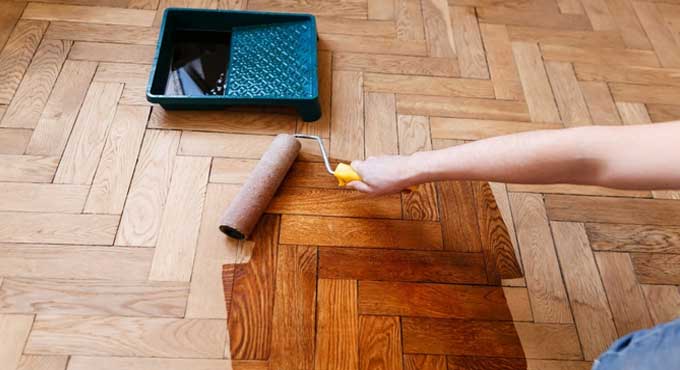
The Timeless Allure of Parquet Flooring: Installation, Maintenance, and Design Ideas

Parquet flooring is a classic choice that has graced the most elegant and historically significant interiors for centuries. This intricate wood flooring pattern consists of small, individual pieces of wood arranged in geometric designs, creating a captivating and timeless aesthetic.
What is Parquet Flooring?
Parquet flooring is a type of wood flooring characterized by its unique geometric patterns and intricate designs. It is often associated with luxury and elegance and has been used in both residential and commercial spaces for centuries.
The term "parquet" originates from the French word "parqueterie," which means "a small compartment." Parquet flooring is constructed by arranging small wooden blocks or strips in various geometric patterns, resulting in a highly decorative and visually appealing surface.
Characteristics of Parquet Flooring
Elegance and Versatility: Parquet flooring adds a touch of timeless elegance to any space. It is adaptable and may be utilised in both classic and modern home design.
1. Variety of Patterns: Parquet flooring comes in a wide range of patterns, including herringbone, chevron, basketweave, and more. These patterns allow for creativity and customization in your flooring design.
2. Durability: High-quality parquet flooring is exceptionally durable and can withstand heavy foot traffic. The wood used is often selected for its strength and resistance to wear and tear.
3. Natural Beauty: The individual wooden pieces in parquet flooring showcase the natural grain and colour variations of the wood, providing a warm and inviting ambience to the space.
4. Repairability: In the event of damage or wear, parquet flooring can be sanded and refinished to restore its original beauty, extending its lifespan.
How to Install Parquet Flooring
Installing parquet flooring is a skilled task that requires attention to detail and precision. Here is a rundown of the installation procedure:
1. Surface Preparation
Before installation, ensure that the subfloor is clean, level, dry, and free from any irregularities. It is essential to have a smooth surface to achieve a flawless parquet floor.
2. Material Selection
Select the type of wood and pattern for your parquet flooring. Common wood species used for parquet include oak, walnut, cherry, and maple. Choose a pattern that complements the room's design and aesthetics.
3. Acclimation
Allow the parquet wood to acclimate to the environment for a few days before installation. This helps to avoid warping and other problems after installation.
4. Glue-Down Installation
Parquet flooring is typically installed using a glue-down method. Apply a high-quality adhesive to the subfloor, and carefully place each piece of parquet, following the chosen pattern. Press the wood firmly into the adhesive to ensure a strong bond.
5. Finishing and Sealing
After installation, sand the surface to achieve a smooth and even finish. Apply a suitable wood finish to protect the floor from moisture and wear. To get the optimum level of protection, many coatings may be required.
Maintaining Parquet Flooring
Proper maintenance is crucial to preserve the beauty and longevity of your parquet flooring:
1. Regular Cleaning: Sweep or vacuum the floor to remove dirt and debris. Use a damp, not wet, mop to clean the surface.
2. Avoid Excess Moisture: Wood is sensitive to moisture, so be cautious with spills and avoid wet mopping. Place rugs or mats in areas prone to moisture, such as entryways and kitchens.
3. Refinishing: Over time, your parquet flooring may show signs of wear. Sand and refinish the floor as needed to restore its original luster.
4. Protect from Furniture: Use felt pads or protective caps on the legs of furniture to prevent scratches and dents.
Design Ideas with Parquet Flooring
Parquet flooring offers a wide range of design possibilities that can enhance the visual appeal of your interior. Consider the following design concepts:
1. Classic Herringbone: The herringbone pattern is a classic choice, offering a timeless and sophisticated look that suits both traditional and modern interiors.
2. Modern Chevron: For a contemporary twist, opt for the chevron pattern. This dynamic design adds a sense of movement and flair to the room.
3. Border Accents: Create a visually striking effect by incorporating border accents or medallions into your parquet floor design. This can highlight specific areas like dining spaces or entryways.
4. Contrasting Wood Species: Combine different wood species to create a distinct contrast within the parquet pattern. This adds depth and character to your flooring.
5. Large-Scale Patterns: Experiment with oversized parquet patterns for a bold and unique statement. These larger patterns can be particularly impactful in spacious living areas.
6. Colour Stains: Explore various wood stain colours to add an extra dimension to your parquet flooring. Different stains can create a more customized and personal look.
To learn more, watch the following video tutorial.
Video Source: Fixing Expert
7. Mix with Other Materials: Incorporate parquet flooring in conjunction with other materials like marble or tiles to create captivating transitions and zones within your interior.
Conclusion
In conclusion, parquet flooring is a timeless choice that can transform any space into an elegant and inviting environment. Its versatility in design, durability, and repairability make it an excellent investment for both residential and commercial spaces.
While it may require professional installation and maintenance, the enduring beauty and classic appeal of parquet flooring are well worth the effort. So, if you are looking to add a touch of luxury to your interior, consider parquet flooring as a top choice that stands the test of time.


